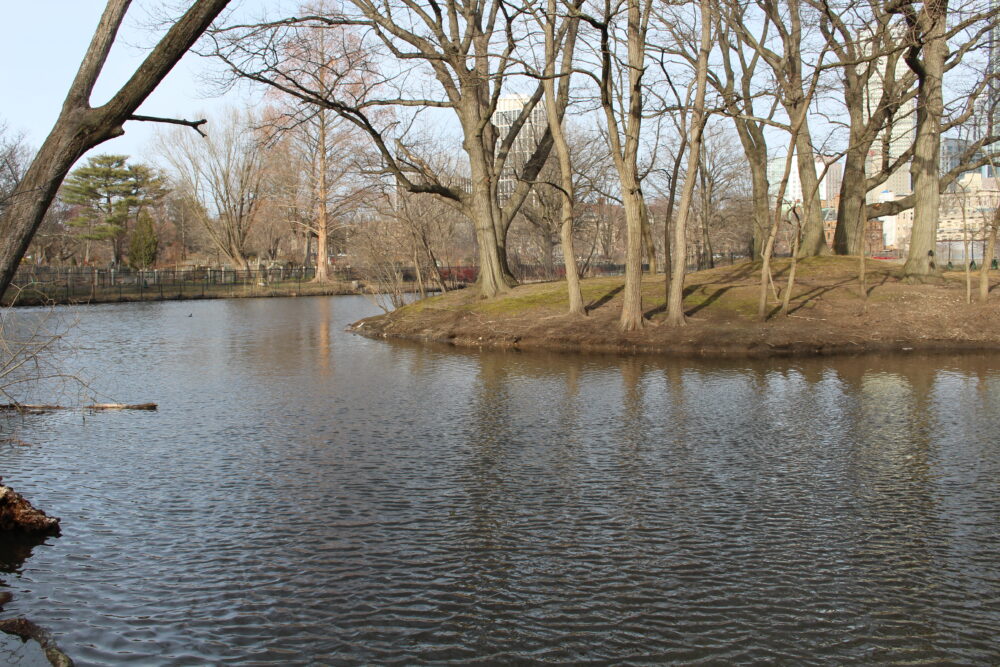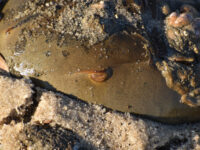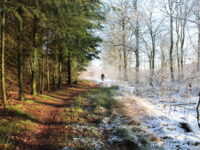Living aboard Aquarius, the world’s only underwater research center, isn’t glamorous. Its interior is about the size of a bus. You eat dehydrated backpacking food with tons of hot sauce because taste buds don’t work as well in the high-pressure atmosphere. There’s a constant mechanical hum and the “ticking” of snapping shrimp.
But Northeastern marine and environmental science professor Brian Helmuth fell in love with underwater missions. “After you have been on there for about three days, you not only become disconnected from the surface — you almost become hostile to it,” Helmuth said. “You feel really like you’re part of the ocean. You start recognizing individual fish and their personalities.”
Helmuth’s research is deeply inspired by his relationship with nature. Looking at ecosystems from the perspective of different organisms has helped Helmuth identify concerning climate change trends that had been previously overlooked. The more he studied ecosystems, the more upsetting and profound climate change felt, and the more he studied climate change, the more he became discontent with the inaction.
Now, he’s shifted his attention to studying what inspires people to act. His studies have led him to form an optimistic vision for the future of climate research and environmentalism: One where even urban residents feel connected with their natural surroundings and where the fight against climate change begins at the local level.
Helmuth grew up in land-locked upstate New York. Next to the area’s slice of the Appalachian mountains, lakes nestled in almost every valley, and forests of birches, firs, and beeches, he was constantly getting his hands dirty. But Helmuth found his true inner calling to nature while sitting inside, glued to the TV.
He watched many of the movies and shows by the oceanographer and prolific filmmaker Jacques Cousteau. After serving in the French Navy, Cousteau became an innovator in scuba diving and underwater filmmaking. His work — with depictions of shipwrecks and the lives of whales, sharks, fish, and otters — fueled the hype around the deep ocean in the 1950s and ‘60s. The hype swept Helmuth into fantasies of underwater exploration and living.
“I love being out in the woods and in remote places … but being in the ocean has always just been my go-to happy place,” said Helmuth. “I love thinking about how marine organisms live in that world … I’m pretty clumsy on land, but underwater … you can be neutrally buoyant and just hover and watch things around you.”
It was this feeling that propelled Helmuth all the way through a master’s degree in marine biology at Northeastern, a PhD in Zoology at the University of Washington, and faculty positions at the University of South Carolina and Northeastern.
In 2014, during his time working on Aquarius off the coast of Florida, Helmuth and fellow Northeastern professor Mark Patterson were asked to assist in the science behind an aquanaut’s 31-day mission at the sea station. It was an attempt to break the record set by Jacques Cousteau 50 years prior for the longest time spent underwater. The aquanaut in question? Cousteau’s grandson, Fabien.
He succeeded, barely. “He looked pretty ragged after 31 days, saying he was just barely surviving,” said Helmuth.
The mission inspired Fabien Cousteau to create his own bold new underwater laboratory, called Proteus. “The idea with Proteus is, what if you live underwater for months at a time and you don’t just survive, but you thrive?” said Helmuth.
Fabien Cousteau recruited a team of over two dozen oceanographers, scientists, and innovators — including Helmuth and Patterson — to essentially create a marine version of the International Space Station, with a continuous presence of aquanauts onboard. (The Proteus team even includes two astronauts.) The underwater station, which is slated to be completed around the end of 2025, will have private aquanaut suites, a renewable energy power plant, and a large central living space.
Helmuth, who serves as the chief scientific officer, is working to develop the scientific capabilities and research goals for the station after it opens. “We want to ask, how do we start doing research on everything from robotics to drug discovery to coral reef health, now?” said Helmuth.
The project is aimed at connecting marine scientists even more directly to the ecosystems they study, yet Helmuth wants to engage as many people as possible in the effort to build connections with nature and protect it.
“I think there are ways to connect what we’re doing underwater with people who may have a similar response to the desert or to the woods,” he said. “This is where it’s really fun to work with storytellers and filmmakers and visual artists and photographers — how do you share this experience with people who are never going to get there?”
Next to Proteus’s scientific and living spaces will sit a video production studio. Fabien Cousteau hopes it will give millions the chance to experience the wonders of the ocean and inspire the next generation of oceanographers and marine scientists to fight climate change and environmental pollution — just as his grandfather inspired Helmuth.
***
Helmuth’s marine ecosystem research had made him deeply concerned about the dangers of climate change, yet he saw little urgency from the public. Naturally, as a scientist, it led Helmuth to become increasingly curious about why people either took action or didn’t — and how to potentially change their minds. Then, a colleague connected Helmuth with Northeastern psychology professor John Coley.
Coley studies human exceptionalism or the idea that humans are somehow above the natural world and are a unique exception from the rest of nature. Coley and others who have researched the phenomenon have outlined how holding this view can lead people to believe they are disconnected from nature — that either humans don’t impact nature or nature doesn’t impact humans. With this view, people are less likely to believe that nature — and consequently climate change — will affect them.
But the question Helmuth wanted to explore with Coley is if this psychological cause-and-effect could work in reverse. Could increasing people’s connection to nature decrease their belief in human exceptionalism and make them more likely to believe in and act on climate change?
“That’s the million-dollar question,” said Coley.
In the duo’s first study together, published in 2021, they presented over 350 adults with differing descriptions of Boston’s Muddy River, a leisurely series of brooks and ponds that flows along the Emerald Necklace, through the Fens park neighboring Northeastern, and into the Charles. The researchers described the river to participants as either human-made or as having natural characteristics. Then, they highlighted either how the river benefits the local community by draining stormwater that could cause flooding or how it benefits the whole globe by filtering pollution out of runoff that ends up in the ocean.
They told everyone that the local, state, and federal governments would need to make significant investments to fix high pollution levels in the river, and asked the participants a series of questions targeted at measuring their levels of human exceptionalism, their connectedness with nature, and how much they were motivated to fix the pollution problem.
They found that the more connected participants felt to the river, the more likely they were to support the theoretical principles of conservation and restoration, including prioritizing river cleanup over reducing local property tax. But even more significantly, they found that participants with lower levels of human exceptionalist thinking and those who lived closer to the river were more likely to invest in the river. They were not only willing to give their money to restoration, but they were also willing to spend time volunteering in a river clean-up.
They followed up the study with a 2023 paper probing human exceptionalism even further. Through an extensive literature review, including Coley’s own work on the problem, they found that exceptionalism is pervasive throughout Western cultures. As technological advancements have created the illusion that humans are separate from nature — with the human territories of cities and towns distinct from natural areas like forests and parks — people have increasingly developed this view. They tend to believe that humans can control nature (as long as they have enough concrete) and that the best way to preserve nature is to simply leave it alone, ignoring the roles humans — and especially indigenous peoples — have played as stewards of the land.
Studying the phenomenon wasn’t enough for Helmuth — he wanted to put theory into practice. So, he started exploring new techniques to engage people — from farmers to city dwellers to environmental scientists — with nature. Through public art projects, citizen science efforts, and now Proteus, Helmuth is trying to squash exceptionalism and disconnectedness in an effort to save the ecosystems he loves.
***
It was a sunny September day in downtown Plymouth, Massachusetts. Pedestrians walked down the grassy tree-covered slopes of the Town Brook and slipped between tarps covering the tunnel under the Market Street bridge. Instead of being treated to a dark, damp passageway, the tunnel walls were lit up with larger-than-life projections of hundreds of herring fish swimming upstream. Sunlight refracted through the water’s surface, illuminating the fish’s warm sandy complexion. Eventually, the scene fades into darkness and only text remains: “Over the years, river herring populations have declined due to habitat loss from dams, road crossings, and other human activities.”
Before colonizers settled in Plymouth, the number of herrings that swam up the brook every year was plentiful — even without a projector. But the Europeans quickly dammed up the stream, blocking the fish species that had used the route for centuries, right past Plymouth Rock, and into the freshwater Billington Sea to reproduce.
With the help of the National Oceanic and Atmospheric Administration (NOAA) and the U.S. Fish and Wildlife Service, Plymouth removed the last dam on the brook in 2019. Since the first dam removal in 2013, the Herring population has slowly been rising, from around 150,000 to over 200,000. The two federal agencies predict the number may eventually top 1 million (which they announced at a homecoming event for the fish).
To raise awareness of this local accomplishment, Helmuth and Coley teamed up with Keith Ellenbogen, a photographer from the Fashion Institute of Technology in New York City. Ellenbogen headed down to Plymouth to film the herring’s return, which the team then projected onto the underside of the bridge.
The project, developed in 2021, was the first major display from the Cognitive Laboratory of Environment and Arts Research (CLEAR) Lab. Since then, the lab has projected a film in Ipswich, Massachusetts, and the team has plans in the works for an installation in the Emerald Necklace.
To help people already with a connection to nature take the next step, Helmuth has worked to get non-scientists actively involved in environmental science and policy decisions. In a 2022 study Helmuth and his PhD student, David Sittenfeld, joined a national citizen science program sponsored by NOAA. With Boston’s Museum of Science, they posted flyers, recruiting residents to record temperatures around the city, which they then used to create a map of extreme urban heat zones. Then, the volunteers and the general public were invited to a policy forum to discuss the findings and brainstorm policy solutions.
“The most important part is bringing them together to discuss potential solutions in a safe space where they can hear other perspectives,” Helmuth said.
Out of the over 350 volunteers from all eight citizen science projects across the nation, the number of volunteers who noted that they understood “a lot” about how nature impacts local communities and vice versa rose from just over 15% to over 50%, and the number of volunteers who strongly agreed that it’s important for their local community to develop climate resilience plans jumped from 48% to 88%.
***
From citizen science to public art to underwater research labs, Helmuth’s work is driven by a simple philosophy: to deeply engage with climate solutions, we first need to get reacquainted with nature. Alongside his many projects, he also teaches ENVR 1101, Introduction to Environmental Science for non majors.
“The one thing I try to get my students to understand is that careers are so vicarious, and if you try to force-fit your way into what you think the right pathway is, you’re going to fail,” he said. “If you play to your strengths and your individual experiences and what you bring to the table [that’s novel], that’s where the solutions come.”






